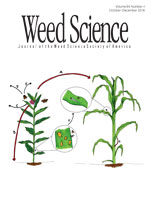Determining the mechanisms of herbicide resistance in weeds allows for the development and implementation of applied management practices aimed to control and to prevent further spread of herbicide-resistant populations in crop fields. This research was conducted to determine propanil resistance and cross-resistance to other photosystem II (PSII) inhibitors in ricefield bulrush biotypes and to elucidate the mechanism of propanil resistance. To this end, propanil-resistant (R) and propanil-susceptible (S) biotypes were selected from field-collected populations after propanil spraying at the field rate, and whole-plant, dose–response experiments were conducted to evaluate cross-resistance to PSII inhibitors and interactions between propanil and the insecticides malathion and carbaryl. In addition, the psbA gene from R and S biotypes was sequenced for amino acid alterations following polymerase chain reaction (PCR) amplification. Plant survival data indicated the R biotype displayed a 14-fold increase in propanil resistance relative to the susceptible (S) biotype. In addition, the propanil-R biotype also had increased resistance to the PSII-inhibitors bromoxynil, diuron, and metribuzin but was more susceptible to bentazon than were propanil-S plants. Synergism between propanil and the insecticides carbaryl and malathion was greater in the S biotype than it was in the R biotype, indicating that, unlike propanil resistance in weedy grasses, enhanced degradation of the herbicide molecule is not a mechanism of resistance for propanil in ricefield bulrush. A Val219 to Ile substitution in the propanil-R chloroplast D1 protein was identified following sequencing of the psbA gene. This research suggests a single-point mutation at the target site causes resistance to propanil, diuron, metribuzin, and bromoxynil but increasing susceptibility to bentazon in propanil-R ricefield bulrush, a novel Val219–Ile feature. To our knowledge, this is the first instance of propanil resistance in weeds because of a mechanism other than enhanced herbicide metabolism. Tank-mixing bentazon and propanil, where permitted, can control both propanil-R and propanil-S biotypes.
Nomenclature: Bentazon; bromoxynil; carbaryl; diuron; malathion; metribuzin; propanil; ricefield bulrush, Schoenoplectus mucronatus (L.) Palla SCPMU.





